The very nice box
art by UM shows basically what comes in the box: an initial version
of the notable T-34 tank with the cast gun mantlet, shorter 30-caliber
76.2-mm gun, cast turret, dish-shaped rubber tired roadwheels, all
painted in a monotone green color. This particular version of the
T-34 could be seen in service with the Red Army from 1940 and probably
into 1942; it’s unlikely that many or any survived to 1943 and
there are no examples remaining of this particular version. An unknown
number of the T-34 mod1940 were captured and used by the Axis.
On the subject of the tank’s names, to use this particular model
for example, I have seen it referred to in references as the T-34-76,
the T-34\76 (1940p.), the T-34 A, T-34(A) and T-34/76 model 1940.
German sources seem to prefer using the A, B, up to F designations
after the T-34 designation. A Russian reference claims that only ‘T-34-76
model 1940’ is the one true designation. My personal preference
is T-34-76 m1940 which I shall use in this preview.

The back of the box shows the recommended
vehicle color of olive green, though some sources advise to use a
dark forest green; I believe both colors and a range in-between could
be found. In the center are UM’s water slide decals for two
vehicles: one of the Soviet 11th Mechanized Corps, July 1941, and
one of the 4th Tank Brigade, October 1941. (Unlike Trumpeter’s
T-34s, UM does identify their vehicle markings! Thank you UM.) The
kit name on the decal sheet can also be used to mark your display
base or bottom of the tank for later identification.
The kit comes with about 60 green injection-molded
styrene vehicle parts with an additional 44 injection molded link
& length track parts, 20 injection molded soft rubber tires, and
several etched brass pieces. The etched brass, seen in this scan,
is not the fine quality of Extra Tech or PART etched brass.
UM reproduces the rear engine deck screen in an odd way using the
etched brass screen directly over the plastic rear deck. The etched
brass saw is not used with this kit.
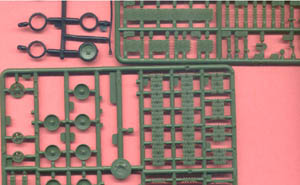
Here are the two Sprue As and four
of the ten soft rubber tires. While most everyone else has molded
their T-34 roadwheels in hard styrene and tracks in soft rubber, UM
molds their roadwheel tires in soft rubber and tracks in hard styrene;
but that’s not necessarily a bad thing. The roadwheel tires
and wheels can be painted separately, and hard tracks seam to be a
general preference among small-scale modelers. Fine detail on the
tires is good for a 1940-41 T-34 tire, but it has an annoying mold
seam around the center that will be difficult to remove. Some modelers
have had experiences of solvents in the rubber roadwheel parts melting
the styrene parts so perhaps do some checking first for compatibility
of the two materials. The dish wheel detail appears good and unlike
the ESCI/Italeri T-34 roadwheel, UM’s roadwheels have the bolt
detail.
Visible at the upper right of the photo are
some of the separate suspension arms for the roadwheels. The separate
arms for the Christy suspension offers us the ability to easily articulate
the roadwheels over rough ground. The rubber tired small idler wheel
at lower left is correct for a 1940-1941 T-34; remember that on a
T-34 the idler wheel is in the front and sprocket is in the rear,
opposite of German, Italian, British and US tanks of the period.
The only real negative point I have
for this sprue A is that UM’s tracks are incorrect for a T-34
of 1940 and 1941. The typical tracks for the m1940 were 500-mm wide
stamped links that had no tread pattern or a very minor pattern. UM’s
tracks are more accurate for a T-34 produced in 1942 and after.
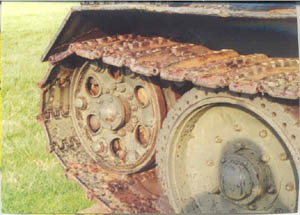
Picture by Stephen Brezinski. Feel
free to print and copy.
Shown above are a rear sprocket and
roadwheel from a T-34-76 m1941 now on display at Aberdeen Proving
Ground, Aberdeen, USA; these are the same as for the m1940. We see
the dish style rubber-tired roadwheel with bolts, and the stamped
500-mm wide track links produced from September 1941. This is an example
of what track should be on our T-34 m1940. [Dragon Models appears
to have got their track correct for their T-34 m1940 kit.]. Several
companies market replacement early T-34 etched brass tracks.
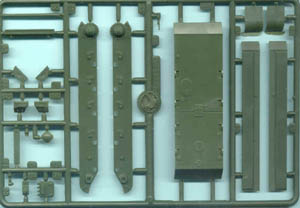
Sprue B carries parts for the lower
hull and chassis. A thing to keep in mind is that UM has released
a range of T-34 variants from the initial T-34 m1940 all the way through
to the T-34-85 and SU 85, etc. It therefore makes sense for UM to
make as many interchangeable parts and common sprues with extra parts
to be more cost effective and save money. Extra parts visible on this
sprue include the F-34 gun mantlet parts and F-34 barrel, and driver’s
hatch for the later m1942 T-34. The separate fender parts at far right
allow UM to change from a T-34-76 with the curved front fender to
a T-34-85 with the angled front fender section with minimum retooling.
In historical photos I’ve noted no hand tools on this early
T-34 model and none are included within UM’s kit.
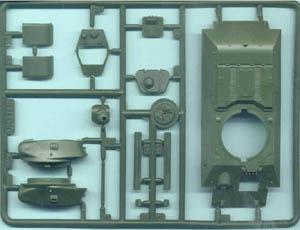
Here, with Sprue C, we have the parts
particular to the T-34 m1940. At lower left is the cast T-34-76 turret,
which is not common on the T-34 m1940, most had welded turrets. The
turret surface is very smooth and can use some texturing and casting
seams. A small mistake on UM’s part was not to mold the rectangular
bolted hatch on the rear of the turret. Fortunately this should be
easy to correct. Another error was not to center the turret’s
side view port directly over the side pistol port, which is not easy
to correct.
At top center is the early driver’s
hatch for the m1940 and m1941 T-34s. At the left is the upper hull
for the m1940 and m1941 T-34s; note that it has the correct side periscopes
just above and on either side of the driver hatch and it has the rectangular
access hatch on the rear plate. Left of center are the cast m1940
pigs head mantlet, short L-11 gun barrel and the turret hatch (which
has no interior detail like ESCI’s m1942 turret hatch).

Picture by Stephen Brezinski
The photo of the m1941 bow is what our m1940
should look like when assembled. Note the bow DT machine gun without
external mantlet and the three periscopes on and above the m1940 and
m1941 driver’s hatch. The U-shaped ring on the hatch is unusual
to me and seeing that this was a T-34 captured from the Germans in
France, this may be a German or Aberdeen modification. Also note the
locations of the two headlights and the pattern on the early stamped
track links. The two towing attachments are particular to the T-34-76
m1940 and m1941. (Some of the fittings on the fenders and hull are
German modifications and should be ignored.) The two rows of bolts
at the point of the glacis were gone by model 1942 T-34s. A subtle
feature in this Aberdeen T-34 is the fine welding and finish work
that we do not see in the wartime production T-34s.
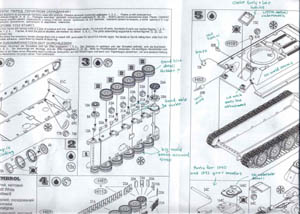
UM’s instructions are the typical black
& white exploded-view kind with sprue and part numbers for each
part. These directions appear complete and easy to understand. At
bottom right we see a bit of the turret assembly. The large single
turret hatch has no detail to the underside of the hatch and there
is no interior kit detail whatsoever. Though the hatch is separate
I would not model it open for a display model without a lot of detailing
work.
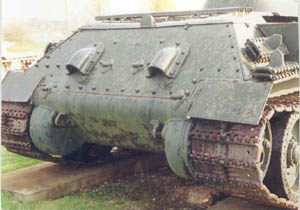
Picture by Stephen Brezinski
The reference photo of the m1941 T-34’s
rear shows the final drive housing for the rear sprockets; the exhaust
pipe armored covers (the exhaust pipes are missing), the bolt detail,
the spare track stowage, and the towing attachments particular to
the m1940 and m1941. The rear access hatch between the exhaust pipes
is the early rectangular type. The towing points are not yet the later
hammerhead style.
|